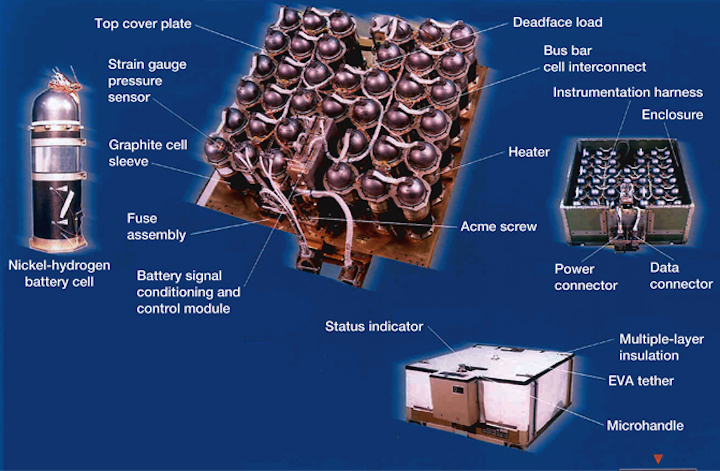24.06.2020
Aboard the International Space Station, Chris Cassidy and Bob Behnken are preparing for two spacewalks that will finish a multi-year battery replacement operation outside the ISS.
The new batteries will increase the outpost’s overall electrical efficiency and aid Station science utilization, which recently allowed scientists to create the fifth element of matter, the Bose-Einstein condensate, for the first time in space.
Battery replacement:
Since the successful launch of the Crew Dragon Endeavour with NASA astronauts Bob Behnken and Doug Hurley, the crew are settling in to life on the Station.
Behnken in particular is preparing with Chris Cassidy for two Extravehicular Activities (EVAs or spacewalks) Friday, 26 June and Wednesday, 1 July 2020.
During the EVAs, the duo will replace the final set of batteries that store power collected from the solar arrays and channel it into the Station’s modules and systems when needed.
Cassidy and Behnken will work on the outer portion of the truss structure, specifically the Starboard 6 (or S6) truss, disconnecting and removing aging nickel-hydrogen batteries and installing new lithium-ion ones.
The scheduled spacewalks will mark the culmination of power upgrade EVAs that began in January 2017 and will be the 228th and 229th in support of Station assembly, maintenance, and upgrade.

The new lithium-ion batteries that will be installed on the EVAs arrived aboard Japan’s HTV-9 craft in late-May and will, in part, help increase the Station’s ability to host more science experiments and payloads.
Creating the fifth state of matter in space:
In 1924, Satyendra Nath Bose proposed a new field of study now called quantum statistics. After reading his paper, Albert Einstein worked in collaboration with Bose, and together they predicted a fifth state of matter (now confirmed) and now called the Bose-Einstein condensate.
A Bose-Einstein condensate is usually formed when extremely low density gasses of bosons are cooled to temperatures very near absolute zero, which is about -273.15℃ (-459.67℉).
At these temperatures, a large portion of the cooled atoms reach the lowest possible quantum state, creating a Bose-Einstein condensate. Here, the condensate displays on a macroscopic, visible to the naked eye, scale what occurs at the atomic and subatomic level.
The first Bose-Einstein condensate was created in a lab at the University of Colorado at Boulder by Cornell and Wieman using rubidium atoms in 1995; hundreds of teams around the world routinely produce the fifth state of matter in labs.
Now, the first Bose-Einstein condensate has been made in space aboard the International Space Station in the Cold Atom Laboratory, developed by NASA’s Jet Propulsion Laboratory at Caltech and launched to the Station in 2018 on the OA-9E cargo resupply mission of Cygnus.
The Cold Atom Lab can cool gases down to near absolute zero and then make use of the Station’s unique microgravity environment to observe quantum phenomena that otherwise can’t be detected or are difficult to study on Earth.
In this case, the Cold Atom Laboratory used Rubidium, a soft and reactive metal just like Potassium, to form the Bose-Einstein condensate. The atoms were corralled and then supercooled. A magnetic trap was then created in the chamber with an electrified coil, which was used along with lasers and other tools to move the atoms in the dense cloud.
At this point, the atoms “kind of blur into one another,” says David Aveline, a physicist at NASA’s JPL and the lead author of the study.
The Bose-Einstein condensate formation on the Station was then released from its magnetic trap and lasted for an impressive 1.118 seconds in free expansion before the super-cooled atoms drifted too far apart to still function as a condensate.
This particular experiment was largely done to prove the advantages offered by the microgravity environment aboard the Station for such an experiment and to prove that the Cold Atom Lab could indeed produce Bose-Einstein condensates as designed.

False-color images showing the formation of a Bose-Einstein condensate in the Cold Atom Laboratory prototype at NASA’s Jet Propulsion Laboratory. (Credit: NASA/JPL-Caltech
While 1.118 seconds might not sound like a lot, “Producing this combination of low temperatures and long expansion times using a simple adjustment to our ground procedure demonstrates not only the natural benefit of microgravity, but also the ability to rely on empirically derived optimization over the course of days, as well as the potential for future improvements,” note Aveline, Williams, Elliot et al. in their paper published last week in the journal Nature.
To be sure, this is the first of many Bose-Einstein condensates researchers seek to create and study aboard the International Space Station with quick repetition.
While this experiment itself and the world of quantum physics might seem completely removed from our ordinary lives, it in fact touches on all facets of our interconnectedness — from cell phones to computers to bluetooth.
Moreover, studying Bose-Einstein condensates could help scientists better understand many of the mysterious phenomena in the universe, from dark energy and gravitational waves to spacecraft navigation and prospecting of subsurface minerals on the Moon and other planetary bodies.
